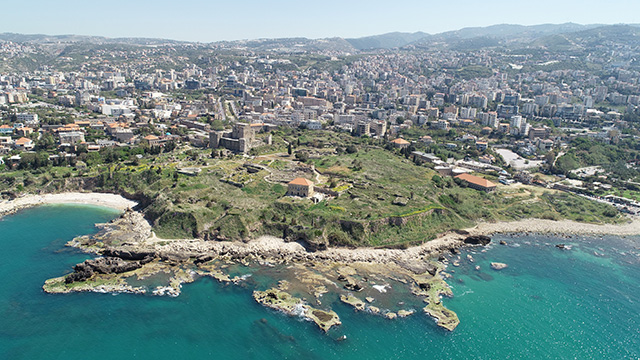 The ancient settlement of Byblos is currently partially surrounded by the modern city of Jbail, Lebanon, on the coast of the Mediterranean Sea, about 38km north of Beirut (the site can be seen in the foreground of the image at the left; hover over to enlarge; image courtesy of the Rijksmuseum van Oudheden, Leiden, the Netherlands). The site is built on a rocky two-hilled promontory set about 30m above sea level. In the valley between the two hills was a well, which became the center of the successive settlements. The site was excavated by Ernest Renan in the 19th century; by Pierre Montet from 1921-24; and then by Maurice Dunand between 1925 and 1973.
The ancient settlement of Byblos is currently partially surrounded by the modern city of Jbail, Lebanon, on the coast of the Mediterranean Sea, about 38km north of Beirut (the site can be seen in the foreground of the image at the left; hover over to enlarge; image courtesy of the Rijksmuseum van Oudheden, Leiden, the Netherlands). The site is built on a rocky two-hilled promontory set about 30m above sea level. In the valley between the two hills was a well, which became the center of the successive settlements. The site was excavated by Ernest Renan in the 19th century; by Pierre Montet from 1921-24; and then by Maurice Dunand between 1925 and 1973.
The history of ancient Byblos (once called Gubla then Gebal) can be traced to an initial settlement during the Neolithic period, around 4500 BCE. The settlement expanded and had a flourishing during the Chalcolithic period, between about 3500 and 3000 BCE (see the Learning Sites model from the menu above). During the Early Bronze Age (c.3000-2300 BCE), the site became an important Canaanite West Semitic coastal city-state and timber and shipbuilding center with close trade connections to Old Kingdom Egypt. Many new temples were built, the well became a sacred setting, and a city wall was added. The growing city saw greater expansion during the Middle Bronze Age (c.1900-1600 BCE; and another period Learning Sites has re-created; use the pull-down menu above). Temples were rebuilt, the city wall thickened and improved, and a large harbor facility appeared to the south of the settlement. Several royal tombs built near the palace show continued ties to Egypt. Byblos' importance continued through the Late Bronze Age, Iron Age, and well after it was conquered by Alexander the Great in 333-332 BCE. It began a decline during the Hellenistic period. During the late Roman period, the city regained its significance and splendor (see the Learning Sites model of the now very large and sprawling city at its peak around 300 CE from the menu above).
We hope you had a chance to visit the exhibition on Byblos at the Rijksmuseum van Oudheden, Leiden, the Netherlands; the show was open through March 12, 2023.
The American University of Beirut held a special program on January 18, 2023, which included a short movie on the Byblos exhibition as well as a lecture by Tania Zaven, archaeologist, Regional Director of North Mount, Lebanon, and Byblos Site Manager of the Ministry of Culture/Directorate General of Antiquities.
Artin, Gassia
2018 "The Chalcolithic Period on the Lebanese Coast," Annalen des Naturhistorischen Museums in Wien, Serie A 120:471-84.
2010 "The Necropolis and Dwellings at Byblos during the Chalcolithic Period: new interpretations," Near Eastern Archaeology 73.2:2-12.
Dunand, Maurice
1968 Byblos: its history, ruins, and legends. 2nd. edn.
1937-73 Fouilles de Byblos. 5 vols.
Fournet, Thibaud
2009 "The Ancient Baths of Southern Syria in their Near Eastern Context: introduction to the Balneorient project," in Ralf Kreiner & Wolfram Letzner, eds. Tagungsband des Internationalen Frontinus-Symposiums zur Technik- und Kulturgeschichte der antiken Thermen, Aachen, 18-22 Marz 2009. (International Symposium on the Technical and Cultural History of Ancient Baths), Aachen: Frontinus-Gesellschaft.
Jidejian, Nina
1971 Byblos through the Ages. Beirut: Dar el-Machereq. 2nd ed.; 1st ed. 1968.
Kowalewska, Arleta
2019 "The Southern Bathhouse of Antiochia Hippos of the Decapolis," pp.261-77 in Michael Eisenberg & Asher Ovadiah, eds. Cornucopia: studies in honor of Arthur Segal. Rome: Bretschneider.
Lauffray, Jean
2008 Fouilles de Byblos, Tome VI: L'urbanisme et l'architecture. De l'époque proto-urbaine à l'occupation amorite (de l'Énéolithique à l'âge du Bronze II) (Bibliothèque Archéologique et Historique, 182). Beirut.
Miniaci, Gianluca
2018 "Deposit F (nos. 15121-15567) in the Obelisk Temple at Byblos: artefact mobility in the Middle Bronze Age I-II (1850-1650 BC) between Egypt and the Levant," Egypt and the Levant 28:379-408.
Sala, Maura
2015 "Early and Middle Bronze Age Temples at Byblos: specificity and Levantine interconnections," BAAL Hors-Serie 10:31-58.
2013 "The Middle Bronze Age stone glacis at Byblos," Scienze Dell'Antichita 19.2/3:179-86.
2007 "Early Shrines at Byblos and Tell es-Sultan / ancient Jericho in the Early Bronze I (3300-3000 BC)," pp.47-68 in Lorenzo Nigro, ed. ROSAPAT 04--Byblos and Jericho in the Early Bronze I: social dynamics and cultural interactions. Rome: La Sapienza.